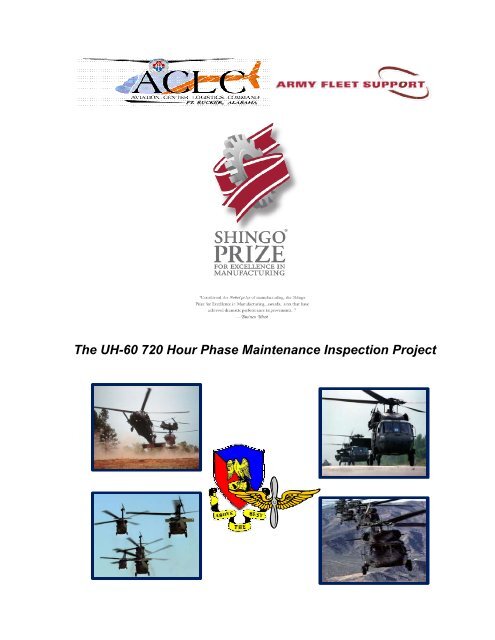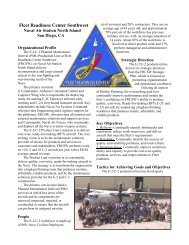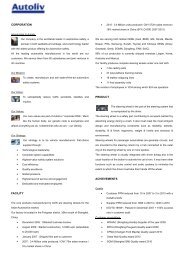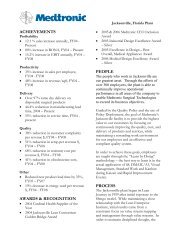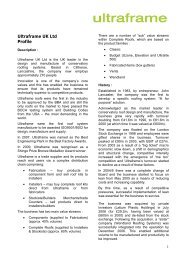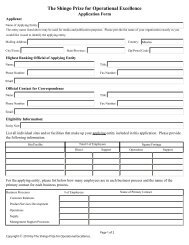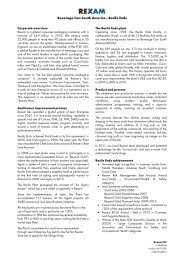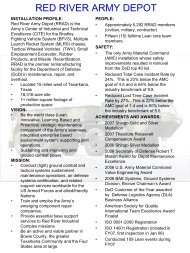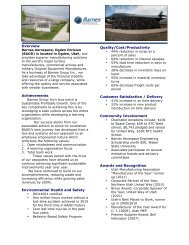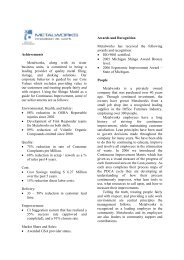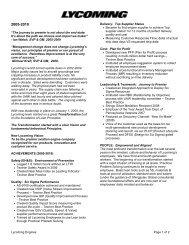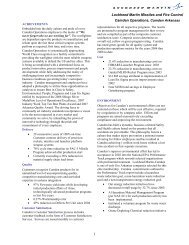Aviation Center Logistics Command and Army ... - The Shingo Prize
Aviation Center Logistics Command and Army ... - The Shingo Prize
Aviation Center Logistics Command and Army ... - The Shingo Prize
Create successful ePaper yourself
Turn your PDF publications into a flip-book with our unique Google optimized e-Paper software.
<strong>The</strong> UH-60 720 Hour Phase Maintenance Inspection Project
Installation Profile<br />
<strong>The</strong> <strong>Aviation</strong> <strong>Center</strong> <strong>Logistics</strong> <strong>Comm<strong>and</strong></strong><br />
(ACLC) <strong>and</strong> <strong>Army</strong> Fleet Support (AFS), form a<br />
Government Owned-Contractor Operated<br />
(GOCO) joint partnership operation in support<br />
of flight training at the USAACE. Flight training<br />
is provided to our nation’s military pilots at Fort<br />
Rucker include multiple aircraft launches over<br />
500 times each day <strong>and</strong> requires 24 hours a<br />
day, seven days a week maintenance, repair<br />
<strong>and</strong> overhaul activities for fleet sustainment.<br />
Fort Rucker is located 25 miles west of Dothan,<br />
Alabama on a 56,000 acre site with 772,000<br />
square footage of space employing over 8,000<br />
military <strong>and</strong> civilian personnel making it one of<br />
the largest employers in the state.<br />
Mission/Vision<br />
ACLC’s mission, as a US <strong>Army</strong> brigade<br />
equivalent organization, is to provide a full<br />
spectrum of aviation maintenance <strong>and</strong> supply<br />
to the U.S. <strong>Army</strong> <strong>Aviation</strong> <strong>Center</strong> of Excellence<br />
(USAACE) to ensure mission capable aircraft<br />
are available for all aviation training <strong>and</strong><br />
mission requirements. AFS’s mission/vision is<br />
to deliver world-class aviation logistical support<br />
by continuously improving our processes;<br />
developing our workforce <strong>and</strong> protecting our<br />
environment, while meeting <strong>and</strong> exceeding our<br />
customer’s requirements through the use of<br />
AFS’s Business Objectives.<br />
Environmental Health <strong>and</strong> Safety<br />
<strong>The</strong> FY08 Environmental Health <strong>and</strong> Safety<br />
program has a Recordable Incident Rate (RIR)<br />
of 3.6 (Industry average is 8.7) <strong>and</strong> Lost Time<br />
Rate is 0.63 (Industry Average is 3.6). Other<br />
programs include DuPont Safety model training<br />
programs, acquisition of fall protection docking<br />
stations, an innovative Hazardous Energy<br />
Control Program, Hexavalent Chromium<br />
mitigation techniques, <strong>and</strong> a close coordination<br />
with the AMCOM G-4 (Environmental) Clean<br />
Laser system for paint stripping, <strong>and</strong> other<br />
environmental pollution prevention programs.<br />
Achievements <strong>and</strong> Awards<br />
• 2008 Runner Up Chief of Staff <strong>Army</strong>,<br />
Supply Excellence Award.<br />
• 2008 HQ AMC Supply Support Activity<br />
of the Year Award.<br />
• 2008 Daniel Pratt Industry Award -<br />
Enterprise Chamber of Commerce.<br />
• 2008 AMC/AMCOM Blacks in<br />
Government Award.<br />
• 2007 <strong>Shingo</strong> <strong>Prize</strong> Winner – Bronze<br />
Award.<br />
• 2007 White House Closing the Circle<br />
Award – Honorable Mention –<br />
Absorbent.<br />
• 2006 FAA national AMT Diamond<br />
Certificate of Excellence Award.<br />
• 2006 Chief of Staff <strong>Army</strong>, Supply<br />
Excellence Award.<br />
• 2006 Workforce Initiative Award –<br />
Enterprise Award.<br />
• 2006 <strong>and</strong> 2007 Employers for the<br />
Support of the Guard <strong>and</strong> Reserve<br />
(ESGR) Award.<br />
• 2005 Disabled American Veterans<br />
Large Employer of the Year.<br />
• 2004 ISO 9001:2000 Certification; Recertification<br />
in 2007.<br />
Additionally the ACLC/AFS Team was the<br />
recipient of the United States <strong>Army</strong> Chief of<br />
Staff of the <strong>Army</strong> Award for outst<strong>and</strong>ing<br />
management of the supply warehouse in 2008.<br />
Also, the ACLC/AFS Team qualified as a<br />
National Maintenance Program provider for<br />
over 56 critical parts.<br />
<strong>Shingo</strong> C<strong>and</strong>idate<br />
ACLC/AFS’s c<strong>and</strong>idate for the <strong>Shingo</strong> <strong>Prize</strong> is<br />
the UH-60 720 Hour Phase Maintenance<br />
Inspection (PMI) Project. Lean concepts were<br />
applied to the 720 hour phased maintenance<br />
inspection to reduce the cycle time, improve<br />
the flow, increase the throughput <strong>and</strong> positively<br />
impact the out-going quality of the UH-60<br />
helicopters.<br />
People<br />
<strong>The</strong> UH-60 Black Hawk is the primary divisionlevel<br />
transport helicopter, providing dramatic<br />
improvements in troop capacity <strong>and</strong> cargo lift<br />
capability compared to the UH-1 Series "Huey"<br />
it replaces. A cross functional team was<br />
formed, consisting of ACLC, Lean-Six Sigma<br />
process experts, aircraft mechanics, support<br />
services personnel, supply technicians, <strong>and</strong><br />
numerous others who touched the phase
maintenancee<br />
process<br />
including<br />
outside<br />
vendors.<br />
Using Principles of<br />
Continuous<br />
Improvement, the empowered team focused on<br />
improving the UH-60 Black Hawk, maintenance<br />
process resulting in finding <strong>and</strong> eliminating<br />
waste, <strong>and</strong> reducing variation. <strong>The</strong> outcomes<br />
were dramatic, with significant improvements<br />
in<br />
First Pass Yield <strong>and</strong> Turn-around Time.<br />
Additionally, numerous<br />
lessons learned <strong>and</strong><br />
benefits of the LEAN improvements in process<br />
flow have been applied to similar processes<br />
within phase<br />
maintenance operations.<br />
Processes<br />
<strong>The</strong> “Beforee & Early efforts Lean/Six Sigma”<br />
picture in the <strong>Army</strong>’s UH60 helicopter training<br />
aircraft was not nearly<br />
as efficient or effective<br />
as<br />
necessary to meet the highh operational<br />
tempo required to support our nation’s defense<br />
commitments was noted in 2007. While cost<br />
effective, an<br />
analysis of the student training<br />
load <strong>and</strong> environmental dem<strong>and</strong>s placed on<br />
this Military Utility Tactical Transport Aircraft<br />
System (UTTAS)<br />
resulted<br />
in<br />
less than<br />
desirable availability<br />
rates due primarily to<br />
excessive down time for phase maintenance<br />
repair. For this reason it was selected to be<br />
one of the first strategic Kaizen events by the<br />
ACLC/AFS Team. By<br />
incorporating Lean/Six<br />
Sigma<br />
Maintenance, Supply<br />
Chain<br />
Management, Repair <strong>and</strong> Overhaul process<br />
improvement techniques so much goodness<br />
<strong>and</strong> stability was serendipitously<br />
achieved that<br />
this project<br />
was nick-named<br />
“the Solidity<br />
Project.” <strong>The</strong> ACLC/AFS team used a process<br />
that included performance tracking to align<br />
resources <strong>and</strong> enhance communication<br />
to<br />
reduce waste in the phase process. In<br />
a<br />
statement by<br />
the former <strong>Comm<strong>and</strong></strong>er of the U.<br />
S. <strong>Army</strong> <strong>Aviation</strong> <strong>and</strong> Missile <strong>Comm<strong>and</strong></strong>: “Lean<br />
Six Sigma was introduced wherever possible<br />
to<br />
optimize operations<br />
<strong>and</strong> reduce operating<br />
costs in the shortest<br />
amount of time.”<br />
(Lieutenant<br />
General James<br />
H. Pillsbury,<br />
Deputy <strong>Comm<strong>and</strong></strong>ing General, U. S. <strong>Army</strong><br />
Materiel <strong>Comm<strong>and</strong></strong>)<br />
As a result of Lean Six Sigma efforts on the<br />
UH-60, several key changes weree made to<br />
facilitate the flow<br />
which included:<br />
• A time saving parts requisition<br />
process<br />
called “Kitting” which included working with<br />
Parts Suppliers to produce two<br />
types of<br />
repair Kits ( that have most often used parts<br />
pre-assembled for ease of use by the<br />
mechanic) so that time <strong>and</strong> manpower is<br />
saved through cost avoidance<br />
process<br />
improvement.<br />
• Providing a st<strong>and</strong>ardized phase<br />
chart for<br />
phase time tracking, assist with<br />
cell floor<br />
decision<br />
making, identify<br />
continuous<br />
improvement opportunities, record delay<br />
issues, <strong>and</strong> communicate future continuous<br />
improvement actions, projects or events.<br />
• With added commitment of upgrading<br />
hanger facilities <strong>and</strong> working with our<br />
School house partners, Value Stream<br />
Mapping identified <strong>and</strong> reduced total<br />
mileage traveled by aircraft from 9.3 miles<br />
to<br />
3.1 miles.<br />
• First Pass Yield improved from 46.1 % in<br />
January 2008 to 84.6 % in September<br />
2008.<br />
• Throughput increased from 3 in October of<br />
2007 to 8 in October of<br />
2008.<br />
• Turn-around<br />
Time (TAT) improved<br />
from<br />
70.7 Days in<br />
January 2006 to 38 in<br />
November 2008.<br />
For more information contact:<br />
Mr. Robert P. Hill<br />
Deputy to the <strong>Comm<strong>and</strong></strong>er, ACLC<br />
Bldg 1100, Dilly<br />
Branch Rd.<br />
Ft Rucker, AL 36362<br />
334 255-9774/Fax: 334 255-3112 Email:<br />
robert.p.hill@conus.army.mil<br />
3


